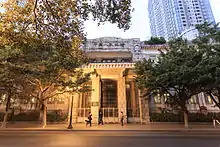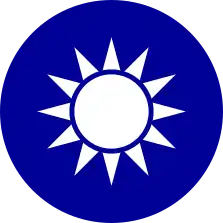Central Bank of the Republic of China (Taiwan)
The Central Bank of the Republic of China (Taiwan) (CBC),[2][3] known in English from 1924 to 2007 as the Central Bank of China,[4] is the central bank of the Republic of China. It was founded in 1924 in Guangzhou, acted as the central for Mainland China until 1949 when it relocated to Taiwan.[5] It took over banknote issuance on the island from the Bank of Taiwan in 1961.
 | |
| Headquarters | Zhongzheng, Taipei |
|---|---|
| Established | 1924 (in Guangzhou) 1928 (in Shanghai) 1949 (in Taipei) |
| Ownership | Executive Yuan of the Central Government of the ROC[1] |
| Governor | Yang Chin-long |
| Central bank of | |
| Currency | New Taiwan Dollar TWD (ISO 4217) |
| Bank rate | 1.5% (22 May 2016) |
| Succeeded by | People's Bank of China (on the mainland) |
| Website | cbc.gov.tw (in English) |
| Central Bank | |||||||||||||||||||||||||
|---|---|---|---|---|---|---|---|---|---|---|---|---|---|---|---|---|---|---|---|---|---|---|---|---|---|
| Traditional Chinese | 中央銀行 | ||||||||||||||||||||||||
| Simplified Chinese | 中央银行 | ||||||||||||||||||||||||
| |||||||||||||||||||||||||
Its legal and common name in Chinese is literally translated as the "Central Bank". The central bank is administered under the Executive Yuan of the ROC government.[6]
History
Mainland China
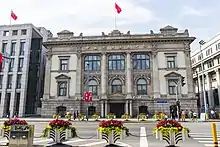
The bank was originally proposed in 1923 by Sun Yat-sen's administration in Guangzhou, and was established a year later under the name Central Bank of China. Following the success of the Northern Expedition, the Central Bank took over the role of the central bank for China from the Bank of China in 1928, with its headquarters in Shanghai. Before 1949, it was one of China's "Big Four" national banks, along with the Bank of China, Bank of Communications, and Farmers Bank of China.
Taiwan
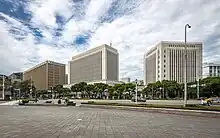
After World War II, Taiwan was retroceded to the Republic of China in 1945, and the Central Bank of China was moved along with the government to Taiwan after losing mainland China in the Chinese Civil War by the Kuomintang (KMT) and its subsequent retreat to Taiwan in December 1949. While the CBC was the island’s central bank from 1949, the Bank of Taiwan, a commercial bank founded in 1897 during Japanese colonial rule, kept issuing banknotes until the CBC assumed that role in 1961. On 8 November 1979, the newly revised Central Bank of China Act was promulgated. The Bank of Taiwan issued the New Taiwan dollar until 2000 when the Central Bank of China finally took over the task. In 2007 the English name of the Central Bank of China was renamed Central Bank of the Republic of China (Taiwan) along with a host of other renamings under the Chen Shui-bian administration of state-owned corporations with "China" in their name, such as the Chunghwa Post.
Organizational structure
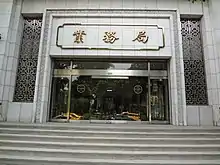
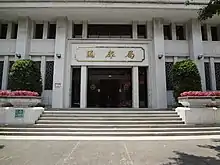
- Department of Banking
- Department of Issuing
- Department of Foreign Exchange
- Department of the Treasury
- Department of Financial Inspection
- Department of Economic Research
- Secretariat
- Department of Accounting
- Department of Information Management
- Personnel Office
- Ethics Office
- Legal Affairs Office
- New York City Representative Office
- London Representative Office
List of governors
| № | Name | Term of office | Days | Cabinet | |
|---|---|---|---|---|---|
| Governor of CBC (Guangzhou) | |||||
| 1 | T. V. Soong (宋子文) | 15 August 1924 | February 1928 | ||
| Governor of CBC | |||||
| 1 | T. V. Soong (宋子文) | February 1928 | December 1931 | ||
| February 1932 | 6 April 1933 | ||||
| 2 | H. H. Kung (孔祥熙) | 6 April 1933 | 26 July 1945 | 4494 | |
| 3 | Yu Hung-chun (俞鴻鈞) | 26 July 1945 | 6 February 1946 | 195 | |
| 4 | Tsuyee Pei (貝祖貽) | 6 February 1946 | 28 February 1947 | 387 | |
| 5 | Chang Kia-ngau (張嘉璈) | 1 March 1947 | 21 May 1948 | 447 | Zhang Qun |
| 6 | Yu Hung-chun (俞鴻鈞) | 21 May 1948 | 19 January 1949 | 243 | Weng Wenhao Sun Fo |
| 7 | Liu Kung-yun (劉攻芸) | 19 January 1949 | 24 June 1949 | 156 | Sun Fo He Yingqin Yan Xishan |
| 8 | Hsu Kan (徐堪) | 24 June 1949 | 5 October 1949 | 1199 | Yan Xishan |
| 9 | Yu Hung-chun (俞鴻鈞) | 26 January 1950 | 1 June 1960[7] | 3779 | Yan Xishan Chen Cheng I Yu Hung-chun Chen Cheng II |
| 10 | Hsu Po-yuan (徐柏園) | 27 July 1960 | 29 April 1969 | 3198 | Chen Cheng II Yen Chia-kan |
| 11 | Yu Kuo-hwa (俞國華) | 25 June 1969 | 30 May 1984 | 5453 | Yen Chia-kan Chiang Ching-kuo Sun Yun-suan Yu Kuo-hua |
| 12 | Chang Chi-cheng (張繼正) | 21 June 1984 | June 1989 | Yu Kuo-hua Lee Huan | |
| 13 | Hsieh Sam-chung (謝森中) | June 1989 | May 1994 | Lee Huan Hau Pei-tsun Lien Chan | |
| 14 | Liang Kuo-shu (梁國樹) | 1 June 1994 | 20 March 1995 | Lien Chan | |
| 15 | Sheu Yuan-dong (許遠東) | 20 March 1995 | 16 February 1998[7] | 1064 | Lien Chan Vincent Siew |
| 16 | Perng Fai-nan (彭淮南) | 25 February 1998 | 26 February 2018[8] | 7306 | Vincent Siew Tang Fei Chang Chun-hsiung I Yu Shyi-kun Frank Hsieh Su Tseng-chang I Chang Chun-hsiung II Liu Chao-shiuan Wu Den-yih Sean Chen Jiang Yi-huah Mao Chi-kuo Chang San-cheng Lin Chuan William Lai |
| 17 | Yang Chin-long (楊金龍) | 26 February 2018 | Incumbent | 2067 | William Lai Su Tseng-chang II Chen Chien-jen |
Access
The headquarters building is accessible within walking distance northwest from Chiang Kai-shek Memorial Hall MRT station of the Taipei Metro.
See also
References
- Weidner, Jan (2017). "The Organisation and Structure of Central Banks" (PDF). Katalog der Deutschen Nationalbibliothek.
- Welcome to the Central Bank of the Republic of China
- "Central bank latest to drop 'China' label". Taipei Times. 11 Feb 2007. p. 1.
- Introduction to the Central Bank of the Republic of China Archived November 28, 2007, at the Wayback Machine (in English)
- "Central Bank of China changes English name". The China Post. 2007-02-11. Retrieved 2007-02-12.
- The Law of the Central Bank, 中央銀行法 Archived December 28, 2007, at the Wayback Machine (in Chinese) (Central Bank Law)
- Died in office.
- Longest-serving governor.
